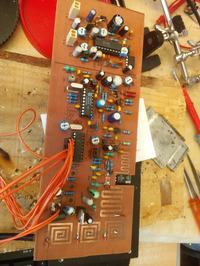Nermin
Newbie level 6
Hi there. I registered today and this is my first thread here. I see that you guys do the help all the time, so my guess is that I will get some help too.
I recently completed fm transmitter ( no tune RDVV ) and I have problem because it is losing lock when power is more than about 0,5 W approximately. Frequency counter says that when it lose lock it goes to frequency about 82-84 MHz. When output power is at small level everything is just fine.
So, probaly some RF field making some problem on board? Dont know now!
Transmitter is very well known design, with tsa5511 and pic16F84. VCO is based on FET j310, buffers are bfr91 and bfr96 and output is 2sc1971.
Only thing that is different from original design is that I placed ba1404 stereo encoder on same PCB, but that should not be the problem. ( probably)
Any guess?
Many thanks bye for now.

I recently completed fm transmitter ( no tune RDVV ) and I have problem because it is losing lock when power is more than about 0,5 W approximately. Frequency counter says that when it lose lock it goes to frequency about 82-84 MHz. When output power is at small level everything is just fine.
So, probaly some RF field making some problem on board? Dont know now!
Transmitter is very well known design, with tsa5511 and pic16F84. VCO is based on FET j310, buffers are bfr91 and bfr96 and output is 2sc1971.
Only thing that is different from original design is that I placed ba1404 stereo encoder on same PCB, but that should not be the problem. ( probably)
Any guess?
Many thanks bye for now.
